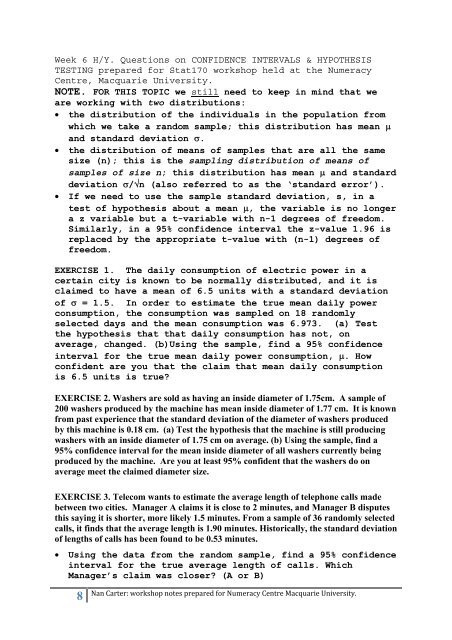STAT170 Workshop Notes prepared by Nan Carter for Numeracy ...
STAT170 Workshop Notes prepared by Nan Carter for Numeracy ...
STAT170 Workshop Notes prepared by Nan Carter for Numeracy ...
You also want an ePaper? Increase the reach of your titles
YUMPU automatically turns print PDFs into web optimized ePapers that Google loves.
Week 6 H/Y. Questions on CONFIDENCE INTERVALS & HYPOTHESIS<br />
TESTING <strong>prepared</strong> <strong>for</strong> Stat170 workshop held at the <strong>Numeracy</strong><br />
Centre, Macquarie University.<br />
NOTE. FOR THIS TOPIC we still need to keep in mind that we<br />
are working with two distributions:<br />
• the distribution of the individuals in the population from<br />
which we take a random sample; this distribution has mean μ<br />
and standard deviation σ.<br />
• the distribution of means of samples that are all the same<br />
size (n); this is the sampling distribution of means of<br />
samples of size n; this distribution has mean μ and standard<br />
deviation σ/√n (also referred to as the ‘standard error’).<br />
• If we need to use the sample standard deviation, s, in a<br />
test of hypothesis about a mean μ, the variable is no longer<br />
a z variable but a t-variable with n-1 degrees of freedom.<br />
Similarly, in a 95% confidence interval the z-value 1.96 is<br />
replaced <strong>by</strong> the appropriate t-value with (n-1) degrees of<br />
freedom.<br />
EXERCISE 1. The daily consumption of electric power in a<br />
certain city is known to be normally distributed, and it is<br />
claimed to have a mean of 6.5 units with a standard deviation<br />
of σ = 1.5. In order to estimate the true mean daily power<br />
consumption, the consumption was sampled on 18 randomly<br />
selected days and the mean consumption was 6.973. (a) Test<br />
the hypothesis that that daily consumption has not, on<br />
average, changed. (b)Using the sample, find a 95% confidence<br />
interval <strong>for</strong> the true mean daily power consumption, μ. How<br />
confident are you that the claim that mean daily consumption<br />
is 6.5 units is true?<br />
EXERCISE 2. Washers are sold as having an inside diameter of 1.75cm. A sample of<br />
200 washers produced <strong>by</strong> the machine has mean inside diameter of 1.77 cm. It is known<br />
from past experience that the standard deviation of the diameter of washers produced<br />
<strong>by</strong> this machine is 0.18 cm. (a) Test the hypothesis that the machine is still producing<br />
washers with an inside diameter of 1.75 cm on average. (b) Using the sample, find a<br />
95% confidence interval <strong>for</strong> the mean inside diameter of all washers currently being<br />
produced <strong>by</strong> the machine. Are you at least 95% confident that the washers do on<br />
average meet the claimed diameter size.<br />
EXERCISE 3. Telecom wants to estimate the average length of telephone calls made<br />
between two cities. Manager A claims it is close to 2 minutes, and Manager B disputes<br />
this saying it is shorter, more likely 1.5 minutes. From a sample of 36 randomly selected<br />
calls, it finds that the average length is 1.90 minutes. Historically, the standard deviation<br />
of lengths of calls has been found to be 0.53 minutes.<br />
• Using the data from the random sample, find a 95% confidence<br />
interval <strong>for</strong> the true average length of calls. Which<br />
Manager’s claim was closer? (A or B)<br />
8<br />
<strong>Nan</strong> <strong>Carter</strong>: workshop notes <strong>prepared</strong> <strong>for</strong> <strong>Numeracy</strong> Centre Macquarie University.
















